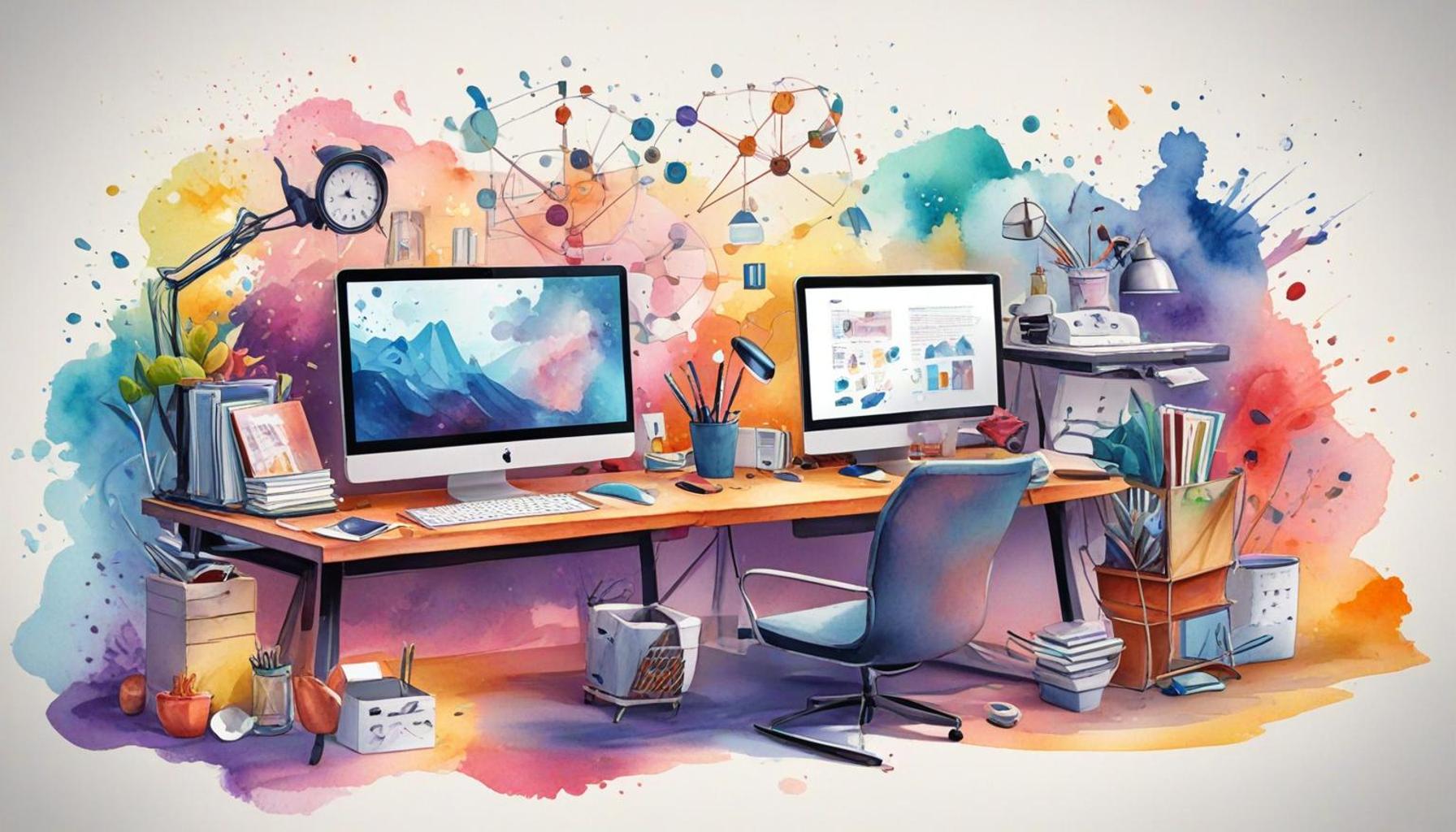Digital Organization Transform Your Workspace with Spatial Efficiency

As remote work becomes the norm, the significance of a well-organized virtual workspace has never been more critical. Digital organization is not just a trend—it is a necessary strategy for enhancing productivity and maintaining focus. By embracing principles of minimalism and personal organization, you can transform your digital environment into a space that fuels creativity and efficiency.
Here are some key insights to consider:
- The Benefits of Minimalism: Reducing digital clutter can lead to improved mental clarity.
- Spatial Efficiency: Organizing digital tools can streamline your workflow.
- Productivity Boost: A tidy workspace fosters better concentration.
In the coming sections, we will explore the Top 5 strategies for enhancing your digital organization. Each method promises to bring you closer to a more efficient workspace, paving the way for greater success in your professional endeavors. Stay tuned as we delve deeper into this transformative journey.
DISCOVER MORE: Click here to simplify your online life
Top 5: Digital Organization – How Spatial Efficiency Can Transform Your Virtual Workspace
In our increasingly digital world, the concept of spatial efficiency has extended into the realm of virtual workspaces. With the surge in remote work and digital interactions, the way we organize our online environment can profoundly impact our productivity, creativity, and mental health. Just as architects and interior designers prioritize spatial efficiency in physical offices, individuals and organizations now recognize the need for a systematically structured virtual workspace. Here, we explore five key elements that can help optimize your virtual environment, ranked from least impactful to most transformative.

5. Clutter-Free Digital Spaces
At the base of any effective digital organization system is a clutter-free environment. Just as a messy desk can affect your ability to think clearly, a digital workspace packed with random files, outdated shortcuts, and a cluttered desktop backdrop can slow down your mental processes. The act of cleaning up digital clutter can be an enlightening experience, providing insights into your past priorities and current needs.
Begin by assessing your desktop and folders. The visual clutter of unnecessary files and icons can be overwhelming. Take deliberate actions to delete or archive items that no longer serve a purpose. Moving your data to cloud-based services like Google Drive, Dropbox, or OneDrive can enhance accessibility while keeping your local system tidy. Cloud solutions not only reduce clutter but also enhance collaboration and data security.
Here are some actionable strategies to ensure a consistently clean digital workspace:
- Set aside 10 minutes each week to declutter your desktop: This regular activity prevents the pile-up of icons and shortcuts.
- Create specific folders for ongoing projects: By categorizing files, you eliminate the need to sift through irrelevant information.
- Regularly review your downloads folder: By organizing and emptying this often-forgotten area, you can prevent potential backlogs.
Creating a clutter-free digital environment is akin to building a solid foundation for a house. It’s the first step towards achieving an efficient virtual workspace, setting the stage for further, deeper transformations.
4. Task Management Systems
Implementing a task management system is crucial for enhancing productivity and ensuring you remain on track with projects and deadlines. The advent of digital tools like Trello, Asana, or Notion has transformed how individuals and teams approach task management. These platforms offer not only a framework for organizing tasks but also interactive features that can help streamline workflows.
To maximize the potential of a task management system, consider the following elements:
- Visual Boards: Offering a snapshot of ongoing tasks, visual boards provide clarity at a glance, allowing teams and individuals to see the status of different projects comprehensively.
- Due Date Reminders: By setting automated reminders, you can remain accountable and aware of approaching deadlines, leading to improved time management.
- Collaboration Features: Seamless communication and real-time project updates within one platform keep everyone on the same page, enhancing productivity.
By adopting a task management tool, you reduce the risk of important tasks slipping through the cracks. With a clear focus on your priorities, you can channel your efforts more effectively, accomplishing more in less time.
3. Living File Systems
A static file system often becomes bloated and inefficient over time. Enter the concept of a living file system, which emphasizes flexibility and adaptability. A dynamic approach to organizing digital files ensures that your virtual workspace evolves alongside your needs and projects.
Here are some techniques for developing a living file system:
- Adopt a “one folder, one project” philosophy: By assigning a dedicated folder to each project, you prevent data mix-ups and facilitate easier information retrieval.
- Use date-based organization: By ordering files according to dates, especially with correspondence or project files, you can quickly retrieve specific documents and track progress.
- Regularly schedule evaluations: By reviewing your file structures periodically, you can make timely modifications to accommodate new projects or changing workflows.
This model of continuous adaptation ensures that your digital workspace is not just a repository of old data but a thriving, active environment that supports your productivity and growth.
2. Automation and Integration Tools
The power of automation and integration tools lies in their ability to streamline routine tasks, providing you more time for innovation and critical thinking. Software like Zapier or IFTTT can connect disparate apps and automate repetitive processes, bringing about an unprecedented level of efficiency.
Consider popular automation integrations that can transform your digital landscape:
- Email sorting: Automatically directing incoming emails to designated folders helps maintain an organized inbox and ensures important messages aren’t overlooked.
- Calendar syncing: By automatically updating your calendar with deadlines and meetings sourced from project management tools, you remain consistently informed and prepared.
- File backups: Automating document backups to the cloud on specific triggers protects your data and ensures peace of mind.
Such automation tools eliminate mundane tasks, freeing up your cognitive bandwidth for projects that require creative or critical input, thereby enhancing overall productivity.
1. Mindfulness in Digital Consumption
Topping our list is the practice of mindfulness in digital consumption. This concept emphasizes being deliberate and aware of how you interact with digital tools and content. In an age where digital distractions are abundant, mindfulness can dramatically enhance focus and reduce mental fatigue.
To cultivate mindfulness, consider these approaches:
- Set specific times to check emails: Resist the urge to be in a constant state of alertness by allocating specific time slots to handle emails, thereby improving focus on primary tasks.
- Limit digital notifications: By permitting only essential alerts, you can minimize interruptions and reduce cognitive overload.
- Engage in regular breaks: Utilize techniques such as the Pomodoro Technique to structure work intervals and rest periods, promoting sustained productivity.
This mindful approach ensures that you remain focused on what truly matters, navigating the digital world with both efficiency and serenity.
Each of these five elements contributes to a more efficient, focused, and supportive digital environment. As our reliance on digital tools continues to grow, adopting such practices becomes essential not only for enhanced productivity but also for improved mental well-being.
| Category | Description |
|---|---|
| Digital Organization Tools | Leveraging applications like Trello or Asana can streamline workflows, making it easier to track tasks and deadlines efficiently. |
| Space Optimization | Proper arrangement of digital files and virtual spaces ensures quick access to necessary resources, reducing clutter and boosting productivity. |
| Collaboration Efficiency | Utilizing shared digital platforms fosters real-time collaboration among team members, breaking down barriers caused by geographical distances. |
| Enhanced Focus | Minimizing digital distractions through organized virtual spaces leads to increased concentration and improved work quality, ultimately transforming workflows. |
In the realm of digital organization, the adoption of digital organization tools has proven to revolutionize workflows. These tools, such as Trello and Asana, allow individuals to segment tasks, prioritize responsibilities, and visualize progress. By effectively managing work through these platforms, employees can save valuable time that can be redirected toward more critical projects. Moreover, the importance of space optimization cannot be overstated. Just as we would declutter a physical desk to enhance our working environment, a digital space requires similar attention. Organizing digital files into logical categories ensures that everyone involved can locate necessary documents swiftly, thus minimizing frustration and enhancing productivity levels.Another significant aspect is collaboration efficiency. With the proliferation of remote work, utilizing shared platforms allows project teams to interact seamlessly, regardless of location. These platforms are designed for real-time updates, ensuring that all members are kept in the loop and fostering a synergistic approach to project management.Lastly, enhanced focus is achievable through organized virtual spaces. By establishing a digital environment that minimizes distractions—like unnecessary notifications or excessive bookmarks—individuals can maintain a higher level of concentration. This focused approach not only increases overall work quality but also leads to the completion of projects in a more timely manner. These components intertwine to shape a modern workspace that not only supports efficiency but also transforms how we perceive productivity in a digital age.
DISCOVER: Click here to enhance your bathroom organization
Frequently Asked Questions About Digital Organization
What is digital organization, and why is it important for my virtual workspace?
Digital organization refers to the systematic arrangement of files, folders, and digital tools within your virtual workspace. It is crucial because a well-organized digital space enhances productivity by reducing time spent searching for documents, increases efficiency through streamlined processes, and improves collaboration by making it easier to share and access information. In an era where remote work is becoming the norm, maintaining a tidy digital environment is more important than ever.
How can spatial efficiency improve my digital workspace experience?
Spatial efficiency involves the optimal use of your digital real estate to ensure that your workspace is not only functional but also conducive to focus and creativity. By organizing your desktop, files, and software interfaces in a logical manner, you can minimize distractions and ensure that everything you need is within easy reach. This approach can greatly enhance your workflow, reduce cognitive load, and thus improve overall performance.
What are some practical tips for organizing my virtual workspace?
Start by categorizing files into specific folders based on project, theme, or type. Regularly declutter these folders by archiving outdated files and deleting duplicates. Utilize cloud storage solutions such as Google Drive or Dropbox to ensure access from anywhere and enhance collaborative efforts. Adopt a consistent naming convention for files and use digital tools like Trello or Asana for task management to ensure a holistic organizational strategy.
How does digital organization affect team collaboration?
Effective digital organization facilitates seamless collaboration among team members by providing easy access to required resources. With clearly defined folder structures and shared document repositories, teams can avoid misunderstandings and redundant work. Moreover, organized digital workspaces enhance transparency and accountability, which is essential for successful remote collaboration. By implementing cloud-based tools, teams can collaborate in real-time, thus promoting a more agile work environment.
What tools can help me maintain an organized digital workspace?
Several tools can assist in maintaining digital orderliness: file management systems like Microsoft OneDrive, communication platforms such as Slack for centralized messaging, project management tools like Monday.com or Notion, and document collaboration software such as Google Workspace. These tools provide the necessary infrastructure to keep your files organized, enhance communication, and streamline project workflows efficiently.
DISCOVER MORE: Click here to find out how to create a calm living space
Conclusion: Embracing Digital Organization
In an era where digital minimalism is more crucial than ever, the transformation of virtual workspaces through efficient spatial organization presents a paradigm shift in how we perceive productivity and personal organization. The article has explored the essential strategies for mastering this transformation, emphasizing the seamless integration of virtual tools and strategies to create an uncluttered digital environment.
Key Takeaways
- Decluttering techniques can significantly enhance focus and productivity by reducing digital distractions and fostering a clear-minded approach.
- Implementing categorization and file management systems promotes easy access and efficient task execution, saving time and reducing stress.
- The use of digital tools, such as task managers and cloud storage, encourages a minimalist digital lifestyle that aligns with personal and professional goals.
- Emphasizing the importance of routine and discipline ensures the long-term sustainability of these organizational systems, enhancing overall digital wellness.
- Customizable workspaces that adapt to individual needs underline the importance of personalization in digital organization.
Ultimately, adopting a digitally organized approach not only contributes to a more efficient work environment but also aligns with the broader principles of minimalism and personal organization. As the digital landscape continues to evolve, embracing these practices allows individuals to reclaim control over their virtual clutter, fostering a harmonious balance between technology and productivity. By prioritizing digital efficiency, we open doors to explore new pathways for innovation and creativity, inspiring us to continually refine our workspaces for optimum success. This transformative journey, once embarked on, reveals a world of endless possibilities for growth and achievement in both professional and personal realms.



